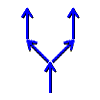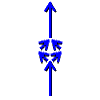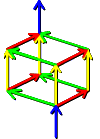Nonlinearity in RPGs
Last significantly updated: 3:48 a.m. EST, June 1, 2003.
This article is a work in progress. I'll post on the RPGDX News board when it's done, so if you're only interested in the finished product, please ignore it for now.
Contents
- Introduction
- Definitions
- Brief Aside: the Role-Playing in RPGs
- The Crazy Consequence of Nonlinearity
- Story and Gameplay
- The Consequence Itself
- When a Game Becomes a Toy
- Nonlinearity and the Player
- Advantages of Nonlinearity
- Advantages of Controlled Nonlinearity
- Advantages of Modular Nonlinearity
- Disadvantages of Nonlinearity
- Disadvantages of Controlled Nonlinearity
- Disadvantages of Modular Nonlinearity
- Conclusion
- Nonlinearity and the Developer
- The Cost of Implementation
- The Cost of Divergent Nonlinearity
- The Cost of Fatalistic Nonlinearity
- The Cost of Modular Nonlinearity
- Retaining a Cohesive Plot
- Cost vs. Benefit
- Conclusion
Introduction
I'll attempt here to determine, to some degree, the place and purpose of non-linearity in RPGs. It's an attempt only: I don't really expect it to be conclusive or comprehensive, though I hope it will at least be useful. I haven't been able to find any other articles on this subject, so if this could at least generate some dialogue I'd consider it worthwhile.
The article is divided into two sections: one theoretical, on what it means when story and gameplay intersect; the other practical, on what advantages and disadantages can be gained by incorporating nonlinearity into an RPG. You're invited to skip the theoretical section, The Crazy Consequence of Nonlinearity, if it doesn't interest you.
I'd like to point out first two articles which in particular have helped me to formulate many of these ideas: The Art of Computer Game Design, and I Have No Words and I Must Design. They are both excellent articles, though more than a little dated, and I would recommend them to anyone interested in computer games of any sort from a development point of view. Reading them is not, however, in any way required to understanding this article.
Definitions
- Linear
- Progressing in a single, pre-determined manner, without the possibility of deviation. In this article I use the terms "linear" and "nonlinear" only in terms of story, except as otherwise noted. Every game, insofar as it truly is a game, is inherently nonlinear, so any binary distinction between these two terms in matters related to gameplay would be trivial.
- Nonlinear
- Progressing in a dynamic manner along a course determined by an element outside the system itself. In this article I use the terms "linear" and "nonlinear" only in terms of story, except as otherwise noted. With regard to plot, it is important to note that a plot does not have to change permanently in order to be termed nonlinear. See fatalistic nonlinearity, below. The plot of a game refers to the entire progression of the story, not just the major points, and not just the lasting events or those accounted for by the developer.
- Divergent Nonlinearity
-
 Refers to a type of nonlinearity in which plots separate completely from each other for long periods, often not intersecting at all, or at least only briefly. Each individual session is still linear in that the plot is never circuitous, i.e., there is no doubling back. Think of the near-end-of-game "turn evil or remain good" choice, it's a classic case of divergent nonlinearity.
Refers to a type of nonlinearity in which plots separate completely from each other for long periods, often not intersecting at all, or at least only briefly. Each individual session is still linear in that the plot is never circuitous, i.e., there is no doubling back. Think of the near-end-of-game "turn evil or remain good" choice, it's a classic case of divergent nonlinearity.
- Fatalistic Nonlinearity
-
 Refers to a type of nonlinearity in which a plot splits but quickly reconverges; generally this is the least consequential but most common type of nonlinearity. The classic example is the "getting into the facility" problem, with two options: 1) killing the guard, or 2) sneaking in through the window. Even though you must get into the facility somehow for the plot to continue, you can choose how you get there.
Refers to a type of nonlinearity in which a plot splits but quickly reconverges; generally this is the least consequential but most common type of nonlinearity. The classic example is the "getting into the facility" problem, with two options: 1) killing the guard, or 2) sneaking in through the window. Even though you must get into the facility somehow for the plot to continue, you can choose how you get there.
- Order-Based Nonlinearity
-
 Refers to a type of nonlinearity in which the only choice allowed the player is the order in which he accomplishes certain tasks. Remember the Mega Man games where you got to choose the order in which you went to the various stages? Often order-based nonlinearity is downright trivial, but not always.
Refers to a type of nonlinearity in which the only choice allowed the player is the order in which he accomplishes certain tasks. Remember the Mega Man games where you got to choose the order in which you went to the various stages? Often order-based nonlinearity is downright trivial, but not always.
- Modular Nonlinearity
-
 A modular plot consists of a variety of smaller plots which can be strung together in various different ways; this is the type of plot I intend to use for Cairn Hill. Optional sub-quests are frequently an element in RPGs, and are usually a type of fatalistic nonlinearity as they do not permanently impact the plot; imagine a game composed entirely of such sub-quests, and you are imagining a modular plot. Modular nonlinearity can be viewed as the most extreme type of nonlinearity allowed by the limitations of the computer at the present time. Since this is, to me, the most interesting (though not the most useful) type of nonlinearity, I go into it in much more depth throughout the article, so don't worry if you don't understand it perfectly quite yet.
A modular plot consists of a variety of smaller plots which can be strung together in various different ways; this is the type of plot I intend to use for Cairn Hill. Optional sub-quests are frequently an element in RPGs, and are usually a type of fatalistic nonlinearity as they do not permanently impact the plot; imagine a game composed entirely of such sub-quests, and you are imagining a modular plot. Modular nonlinearity can be viewed as the most extreme type of nonlinearity allowed by the limitations of the computer at the present time. Since this is, to me, the most interesting (though not the most useful) type of nonlinearity, I go into it in much more depth throughout the article, so don't worry if you don't understand it perfectly quite yet.
- Wild Spaghetti Nonlinearity
-
 Refers to a type of nonlinearity which can fork wildly in a number ways at all sorts of different times, and can but does not necessarily backtrack. This type of nonlinearity is reserved pretty much exclusively for P&P RPGs, but I thought it was worth mentioning. It's also worth mentioning that almost all gameplay would fall under this type of nonlinearity.
Refers to a type of nonlinearity which can fork wildly in a number ways at all sorts of different times, and can but does not necessarily backtrack. This type of nonlinearity is reserved pretty much exclusively for P&P RPGs, but I thought it was worth mentioning. It's also worth mentioning that almost all gameplay would fall under this type of nonlinearity.
- Controlled Nonlinearity
- This is an umbrella term used to refer to those types of nonlinearity (divergent, fatalistic, and order-based) in which the developer is still the one in primary control over the plot, as opposed to modular nonlinearity, which to a much greater degree forces the player to construct his own plot (though of course still within the bounds of whatever structures and themes the designer has created).
- RPG
- A CRPG (see below). In the section the Role-Playing in RPGs, RPG instead refers to the proto-game which fathered both CRPGs and P&P RPGs. It may seem confusing here, but it's not so bad when you actually get into it.
- CRPG
- A computer game in which, well, I'm not really going to bother defining a CRPG here, since I hope we all know what one is, and this article's going to be long enough already. Do note, though, that I include console games, Rogue-likes, etc.; any one player game, really, that comes at you through your computer.
- P&P RPG
- A "pen and paper" game in which you take up the role of a character, existing in a world created and actively controlled by another person. There are probably better definitions, but I imagine you likely know what I mean by this, too.
Taking the Role-Playing back out of RPGs
This is sort of an aside, but it may be useful. You certainly do not have to read it to understand the rest of the article, and you're encouraged not to read it if the topic is not of interest to you.
In support of nonlinearity, I've sometimes heard the argument made (and I'm sure I've made it myself at times, too), that we should try to "put the role-playing back in RPGs". Unfortunately, this is really a slogan and not an argument, and never serves to stimulate useful discussion (never in my experience, any way). What's more, it doesn't really make historical sense.
Now, I wasn't born until much later than most of these events, so please feel free to correct my errors, but as I understand it the evolution of the term RPG goes something like this: in the early 70s or so, a game called Chainmail came out, which sprang directly from the large-scale mock-war games which were popular at the time (sort of like Warhammer). The difference between these games and Chainmail was that Chainmail took place at the individual level, with each player playing the role of a single character. Chainmail had long lists of statistical interaction; it had about as much room for improvisation as Warhammer does now. Dungeons and Dragons inherited directly from this, and at its early stages, wasn't too much more than a sort of fantasy-based combat sim.
It is at this stage of RPG development that Rogue and its clones stepped in, doing the best they could to simulate the feel of D&D, which, I repeat, was basically a combat sim.
From that stage CRPGs and P&P RPGs developed along parallel lines with little interaction. P&P RPGs became much more character- and story-based and less statistic-heavy. It is true that CRPGs have done the same, but to a much lesser degree.
In this way, regarding plot nonlinearity vs. rigid plot progression, CRPGs have actually stayed much closer to their early RPG roots than P&P RPGs have.
So, what's the point of all this? Well, partly, I'm pedantic, and wanted to correct a little error, but it's also important, I think, for people to know that CRPGs are not some degenerate offshoot of the modern type of P&P RPG, but rather the two are equal siblings. Also, the subtle shift from "put the role-playing back in RPGs" to "add more role-playing to RPGs", seems to me to encourage more discussion and less arguing, as it hinges less on some sort of poor, but often oddly compelling, invocation of natural order, or something odd like that.
For a non-historical discussion of why a CRPG hardly ever encourages role-playing in the strictest sense, check out http://www.costik.com/nowords.html#Role.
The Crazy Consequence of Nonlinearity
This section, the Crazy Etc., deals with the theoretical implications of nonlinear plot, particularly with the intersection it creates between story and gameplay. If theory bores you, feel free to skip it and go straight to Nonlinearity and the Player.
Gameplay and Story
Every element in an RPG has two aspects: a gameplay aspect, and a story aspect. There are very rare times when this can be untrue, but it is almost always the case.
Gameplay can be defined as the process whereby a player makes choices in order to advance towards ultimate victory. For example, pressing the SPACE bar in order to advance the text in a cut-scene is a trivial decision, it is not really a choice, and hence not a gameplay element; equipping a sword instead of a stick because it raises your attack power is a choice, and it is obviously undertaken in an attempt to achieve some sort of ultimate victory.
Story consists of plot, and the translation of gameplay elements (I'll explain these later).
The core gameplay itself is unrelated to story. Here is an example of a game (feel free to glaze over the rest of this paragraph, as it's quite dry): the player controls a token which contains quantities for elements a, b, c, d, and e. Each game phase he may increment or decrement either his d or e quantities. There are also other tokens uncontrolled by the player with quantities for elements a, b, c, d, and e; these also increment or decrement their d or e quantities each game phase. If ever two tokens have d quantities equal, and e quantities differing by only one, or vice versa, each reduces its c quantity by an amount to the other's a quantity minus it's own b quantity. If a token's c quantity is reduced to 0 or below, it is removed; if a player's token is removed, he loses the game. The player wins the game by setting his d and e quantity to some arbitrary position determined before the game begins.
The game above is a standard dungeon-romp, minus dungeon and any other story aspect. The player's token is the PC, the other tokens are enemy NPCs, goblins, monsters, and such, and a, b, c, d, and e are respectively ATT, DEF, HP, x position, and y position. As you can see, the underlying representation of the game is highly mathematical and very inaccessible: the game above didn't even take the to us obvious step of representing values d and e as position on a grid. A grid would be a great and logical addition to this poor game I've devised, because it makes the game more accessible; but it is not intrinsic to the game itself.
Most computer games do break down into being, at core, these very abstract (from a human standpoint) mathematical systems. In the definition above, in which every game is a closed system, it seems inevitable that every computer game should be so mathematical. Therefore in most cases the act of playing a computer game is really a combination of heuristic selection and calculation (although since the more complex calculation is almost always represented in spatial terms, this at least tends to be a fairly unconscious process). Yet games are fun, while math class isn't (at least, not to me, and not to many; and to those to whom it is, I think we can all agree that they aren't fun in the same way). Why is this, if they involve essentially the same thing?
Well, I'm not going to bog this down more than it already has been in a general discussion of why games are fun (for that there's an excellent article, The Art of Computer Game Design). There are as many reasons as there are games (well, almost); the one most appropriate to this discussion is not coincidentally also the one most unique to RPGs: story.
There are many games which, while very abstract and removed from life, are dyed in human colours so that we can learn and enjoy them more easily. Chess casts its pieces as military units, and playing cards have faces. Some games are very abstract, like checkers and go, but even checkers are "crowned", and both are still set on a grid, something not fundamental to the underlying mathematics of the games. I call all these things "story aspects".
A game's story includes any attempt to translate gameplay elements in human terms. Therefore an RPG Strength score is an element with two aspects: a gameplay aspect (in which it is simply variable "a", by the quantity of which another token's "c" variable is reduced), and a story aspect (its translation as a Strength score, and, well, we all know what strength is, the entire point is that we should all know what it is).
Above, I say that story consists of plot (in which I include characters and setting; this is a video-game article, not an English essay) and translations; but there is great, great overlap between these two. For example, a sword is a translation, but it is also an indication of setting and a character's personality. If a game takes great care to be historically accurate, weaponry and armour can indicate much more besides, such as social class. Unlike the differentiation between gameplay and story, I find the distinction between translation and plot in this case much more difficult. This difficulty is compounded by the fact that the story should be thought of as consisting not only of what the developer puts into the game, but also in what the player brings to it.
The Crazy Consequence Itself
Johnny loves RPGs, but he has a problem not connected to RPGs at all: he's rather dissatisfied with the, um, extent of his manhood. Whenever he plays an RPG, he always goes straight for the biggest sword, biggest gun, biggest whatever (Johnny loved Final Fantasy 7). So Johnny doesn't give a damn that the Dagger of Magic Power gives him infinite MP and +100 MagAtt, he's swinging around his Greatsword of Overcompensation. Johnny's not making a gameplay choice, he's making a story-based choice.
As I said before, gameplay is a closed system. The only way to allow the player to bring the accumulation of his life's experience to it is to retranslate its elements into ones with which the player is familiar. This is necessary: indeed without it an RPG is practically unplayable; but in linking the game to the real world in such a manner, you can never be sure quite what the player is bringing in with him. You are, in effect, opening up the gameplay to the outside world.
So, in every RPG, you have a certain amount of non-gameplay choice. If the player cannot determine any significant gameplay advantage between two things, he will choose the one which better suits his personality. This is fine and almost always makes for a better, more entertaining game.
However, when you have a nonlinear plot, you force the player to make decisions which often are entirely without the scope of gameplay. He often has nothing on which to base his choice but outside knowledge or experience. If the player chooses to defend a town rather than leave it helpless, this is a personal choice based on a system of ethics (or something) which the player has taken from the outside world and put into the game world.
Gameplay has been defined above as a (mostly) closed system in which the player makes choices in order to advance towards a goal. It may seem odd, but in light of the above, we can give plot nonlinearity a very, very similar definition: plot nonlinearity is the extension of outside schema into the game world in order that the player can make choices.
The above definition is a little odd, admittedly, but it does serve to point out the differences and similarities between gameplay and nonlinear plot. Both centre on player choice; the difference is the source of the data on which that choice is based, and the end to which that choice is made. In other words, the main differences are that the elements needed for plot (rather than gameplay) decisions are in large part brought to the game by the player, and that, similarly, the choices made are not geared towards any goal contained within the game, and there can be no simple distinction between right or wrong, good or bad choices.
When a Game Becomes a Toy
A toy has no victory conditions. When can it be said that you win at Slinky, or at plastic soldiers. Toys have no goals but self-satisfaction.
A game, on the other hand, has a very explicit goal. You win when you reach the treasure, get a hand higher than the dealer's but lower than 22, or whatever.
A standard, linear RPG is in all ways a game. The goal is generally to keep your characters more powerful than the enemies they face while the game progresses. If you are more powerful than the last enemy the game throws at you, you win. There are variations, but this pattern is common enough to serve. The point is that every decision you make in the game is intended to make your characters strong enough to overcome their enemies and defeat the last boss.
Some (perhaps most) nonlinear plot choices fit into this pattern. Do you go through the dungeon or over the mountain? The dungeon is likely to be tougher but have more enemies: is it worth the risk? This choice (if viewed in this manner) is a gameplay choice, and the RPG in which it's found remains in every respect a game.
But other choices do not fit so well. Do you torture and kill your captive to get him to talk, or do you imprison him? If you look at this question from purely a gameplay point of view, the choice seems obvious: torture and death gains you information, whereas imprisonment gains you nothing except the chance that he will escape to bother you again. But the player does not look only at the gameplay elements, he also considers his aversion to such things as torture (or his taste for it, as the case may be).
Often the choices made in a nonlinear RPG do not serve to advance the player towards his goal, but rather to attain some sort of inner satisfation. When this happens, the RPG moves away from being a game. The more decisions unrelated to gameplay the player makes, the closer the RPG comes to being a toy.
Nonlinearity and the Player
I would never recommend making an RPG more nonlinear if I did not think that it made the game more entertaining. That said, nonlinearity is not always advantageous, and even when it is there are many pitfalls to be avoided. This section endeavours to show when and how implementing nonlinearity can make an RPG more enjoyable.
It's not always easy to draw a distinct line between player issues and developer issues; some things you might expect to see here, in particular some of the problems nonlinearity raises, are actually covered in the section nonlinearity and the designer.
Advantages of Controlled Nonlinearity
I'll begin with one of the most trivial uses of nonlinearity, as a way to break up long narratives or cut-scenes. These scenes are often useful to establish or maintain plot, but usually consist of the player being talked at by the village elder, great wizard, or other "wise old man" archetype. Maintaining player interest during this scene is difficult, and usually requires a fair amount of talent in writing dialogue (or rather monologue, as this is unfortuantely often what it devolves into).
One way to deal with this long stretch of exposition, during which the player usually sits passive, is to give the player small, fatalistic choices to make throughout. These will not change the grand plot, or even the overall course of the conversation, but they do allow the player a slight reprieve.
This is the most common type of nonlinearity in RPGs, but it is often done poorly. It is important that, since you are not allowing the player to change the overall plot, you do not deceive the player into thinking that he will be allowed to do so. As a general rule, consider that frustration rises with futility. Generally, you should avoid letting the player make selections which, if realized, would affect the plot in a way you would not allow. Perhaps the best thing to do is to keep the player's choices related to his own impressions or motivations.
Nonlinearity and the Designer
This is the end, so far (sorry). My, this is taking longer than I thought it would. Everything's just so inter-related that it seems hard to say anything, really. Oh, well.
 Refers to a type of nonlinearity in which plots separate completely from each other for long periods, often not intersecting at all, or at least only briefly. Each individual session is still linear in that the plot is never circuitous, i.e., there is no doubling back. Think of the near-end-of-game "turn evil or remain good" choice, it's a classic case of divergent nonlinearity.
Refers to a type of nonlinearity in which plots separate completely from each other for long periods, often not intersecting at all, or at least only briefly. Each individual session is still linear in that the plot is never circuitous, i.e., there is no doubling back. Think of the near-end-of-game "turn evil or remain good" choice, it's a classic case of divergent nonlinearity. Refers to a type of nonlinearity in which a plot splits but quickly reconverges; generally this is the least consequential but most common type of nonlinearity. The classic example is the "getting into the facility" problem, with two options: 1) killing the guard, or 2) sneaking in through the window. Even though you must get into the facility somehow for the plot to continue, you can choose how you get there.
Refers to a type of nonlinearity in which a plot splits but quickly reconverges; generally this is the least consequential but most common type of nonlinearity. The classic example is the "getting into the facility" problem, with two options: 1) killing the guard, or 2) sneaking in through the window. Even though you must get into the facility somehow for the plot to continue, you can choose how you get there. Refers to a type of nonlinearity in which the only choice allowed the player is the order in which he accomplishes certain tasks. Remember the Mega Man games where you got to choose the order in which you went to the various stages? Often order-based nonlinearity is downright trivial, but not always.
Refers to a type of nonlinearity in which the only choice allowed the player is the order in which he accomplishes certain tasks. Remember the Mega Man games where you got to choose the order in which you went to the various stages? Often order-based nonlinearity is downright trivial, but not always. A modular plot consists of a variety of smaller plots which can be strung together in various different ways; this is the type of plot I intend to use for Cairn Hill. Optional sub-quests are frequently an element in RPGs, and are usually a type of fatalistic nonlinearity as they do not permanently impact the plot; imagine a game composed entirely of such sub-quests, and you are imagining a modular plot. Modular nonlinearity can be viewed as the most extreme type of nonlinearity allowed by the limitations of the computer at the present time. Since this is, to me, the most interesting (though not the most useful) type of nonlinearity, I go into it in much more depth throughout the article, so don't worry if you don't understand it perfectly quite yet.
A modular plot consists of a variety of smaller plots which can be strung together in various different ways; this is the type of plot I intend to use for Cairn Hill. Optional sub-quests are frequently an element in RPGs, and are usually a type of fatalistic nonlinearity as they do not permanently impact the plot; imagine a game composed entirely of such sub-quests, and you are imagining a modular plot. Modular nonlinearity can be viewed as the most extreme type of nonlinearity allowed by the limitations of the computer at the present time. Since this is, to me, the most interesting (though not the most useful) type of nonlinearity, I go into it in much more depth throughout the article, so don't worry if you don't understand it perfectly quite yet. Refers to a type of nonlinearity which can fork wildly in a number ways at all sorts of different times, and can but does not necessarily backtrack. This type of nonlinearity is reserved pretty much exclusively for P&P RPGs, but I thought it was worth mentioning. It's also worth mentioning that almost all gameplay would fall under this type of nonlinearity.
Refers to a type of nonlinearity which can fork wildly in a number ways at all sorts of different times, and can but does not necessarily backtrack. This type of nonlinearity is reserved pretty much exclusively for P&P RPGs, but I thought it was worth mentioning. It's also worth mentioning that almost all gameplay would fall under this type of nonlinearity.